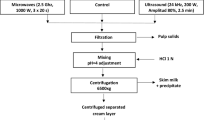Abstract
Fresh and mature coconuts were subjected to deshelling, paring and disintegration. The coconut milk was extracted, treated with an enzyme (protease) at different concentrations and centrifuged, in order to separate it into coconut cream and aqueous phases. Subsequently, coconut cream was subjected to chilling (different temperatures) and thawing to ambient temperature (29 ± 2 °C) followed by centrifugation to obtain a clear virgin coconut oil (VCO). Coconut milk treated with aspartic protease at concentration of 0.02 mg/g, resulted in 90.4 ± 1.2% yield. A maximum yield of 95.3 ± 1.0% was obtained when the treatment of coconut milk with aspartic protease at concentration of 0.02 mg/g was followed by chilling (5 °C) and thawing. Physicochemical properties and fatty acid compositions were evaluated and compared with commercial coconut oil samples. It was found that the oil obtained from present study is low with respect to free fatty acids (0.31%) and peroxide value (0.81 mequiv O2/kg) when compared with the commercial coconut oil samples. Sensory evaluation was also carried out to ensure the product acceptability.




Similar content being viewed by others
References
Nattapol T, Coupland JN (2005) Effect of heating and homogenization on the stability of coconut milk emulsions. J Food Sci 70(8):466–470
McGlone OC, Canales ALM, Carter JV (1986) Coconut oil extraction by a new enzymatic process. J Food Sci 51(3):695–697
Seow CC, Gwee CN (1997) Coconut milk: chemistry and technology. Int J Food Sci Technol 32:189–201
Marina AM, Che Man YB, Amin I (2009) Virgin coconut oil: emerging functional food oil. Trends Food Sci Technol 20:481–487
Madhavan K, Naresh Kumar S, Azez Shamina (2005) Virgin coconut oil by fermentation method. Indian Coconut J 4:8–9
Nevin KG, Rajamohan T (2004) Beneficial effects of virgin coconut oil on lipid parameters and in vitro LDL oxidation. Clin Biochem 37:830–835
German JB, Dillard CJ (2004) Saturated fats: what dietary intake? Am J Clin Nutr 80:550–559
Van Immerseel F, De Buck J, Boyen F, Bohez L, Pasmans F, Volf J (2004) Medium chain fatty acids decrease colonization and invasion through hilA suppression shortly after infection of chickens with Salmonella enterica serovar enteritidis. Appl Environ Microbiol 70(6):3582–3587
Rethinam P (2004) Virgin coconut oil applications. Indian Coconut J 4:5–7
Rele AS, Mohile RB (2003) Effect of mineral oil, sunflower oil and coconut oil on prevention of hair damage. J Cosmet Sci 54:175–192
Blance JV, Marsha L, Concepcion CL (2007) Descriptive sensory evaluation of virgin coconut oil and refined, bleached and deodorized coconut oil. Lebensm Wiss-u-Technol 40:193–199
Lamsal BP, Johnson LA (2007) Separating oil from aqueous extraction fractions of soybean. J Am Oil Chem Soc 84:785–792
Rosenthal A, Pyle DL, Niranjan K (1996) Aqueous and enzymatic processes for edible oil extraction. Enzym Microb Technol 19:402–420
AOAC (1990) Official methods of analysis, 15th edn. Association of Official Analytical Chemists, USA
AOAC (2000) Official methods of analysis, 17th edn. Association of Official Analytical Chemists, USA
IUPAC (1987) Standard methods for the analysis of oils, fats and derivatives. In: Paquot C (ed) 7th revised and enlarged edition. Blackwell, London, pp 174–182
Morrison MR, Smith M (1964) Preparation of fatty acid methyl esters and dimethylacetals from lipid with boron fluoride–methanol. J Lipid Res 5:600–608
AOCS (1998) Official methods and recommended practices of the American Oil Chemists’ Society. In: Firestone D (ed) 5th edn, vol 1. AOCS Press, Champaign, USA
Stone H, Sidol J, Olivers S, Woolsay A, Single ton RC (1974) Quantitative descriptive analysis: developments, application and the future. Food Technol 28(11):28–34
Dravieks A (1985) Atlas of odor character profile. ASTM data series AS 61, ASTM, West Conshohocken
Barrios VA, Ocmos DA, Noyola RA, Lopez-Munguia CA (1990) Optimization of an enzymatic process for coconut oil extraction. Oleagineux 45(1):35–42
Gunetileke KG, Laurentius SF (1974) Conditions for the separation of oil and protein from coconut oil milk emulsion. J Food Sci 39:230–233
Marina AM, Che Man YB, Nazimah SAH, Amin I (2009) Chemical properties of virgin coconut oil. J Am Oil Chem Soc 86:301–307
Norulaini NAN, Setianto WB, Zaidul ISM, Nawi AH, Azizi CYM, Omar AKM (2009) Effect of supercritical carbon dioxide extraction parameters on virgin coconut oil yield and medium-chain triglyceride content. Food Chem 116(1):193–197
Mensink RP, Zock PL, Kester ADM, Kattan MB (2003) Effects of dietary fatty acids and carbohydrates on the ratio of serum total to HDL cholesterol and on serum lipids and apolipoproteins: a meta-analysis of 60 controlled trials. Am J Clin Nutr 77(5):1146–1155
Che Man YB, Abdul Karim MIB, Teng CT (1997) Extraction of coconut oil with Lactobacillus plantarum 1041 IAM. J Am Oil Chem Soc 74:1115–1119
Nevin KG, Rajamohan T (2006) Virgin coconut oil supplemented diet increases the antioxidant status in rats. Food Chem 99:260–266
Onyeike EN, Acheru GN (2002) Chemical composition of selected Nigerian oil seeds and physicochemical properties of the oil extracts. Food Chem 77:431–437
Osawa CC, Goncalves LAG, Ragazzi S (2007) Correlation between free fatty acids of vegetable oil evaluated by rapid tests and by the official method. J Food Comp Anal 20:523–528
Acknowledgments
The authors wish to thank Dr. V. Prakash, Director, CFTRI, for his constant encouragement and keen interest in the area of coconut processing. The authors greatly acknowledge the Coconut Development Board (CDB), Government of India, Kochi, Kerala, for financial support. Thanks are also due to Dr. N. K. Rastogi and Dr. K. Venkatesh Murthy for their valuable suggestions. One of the authors S. N. Raghavendra acknowledges the CSIR, Government of India for providing the CSIR-SRF fellowship.
Author information
Authors and Affiliations
Corresponding author
About this article
Cite this article
Raghavendra, S.N., Raghavarao, K.S.M.S. Aqueous Extraction and Enzymatic Destabilization of Coconut Milk Emulsions. J Am Oil Chem Soc 88, 481–487 (2011). https://doi.org/10.1007/s11746-010-1695-6
Received:
Revised:
Accepted:
Published:
Issue Date:
DOI: https://doi.org/10.1007/s11746-010-1695-6




